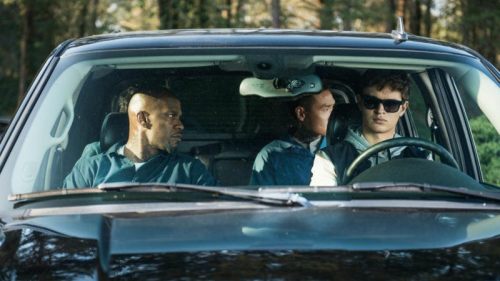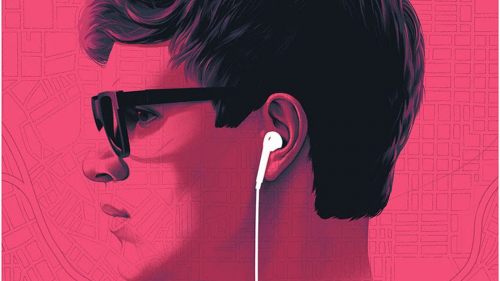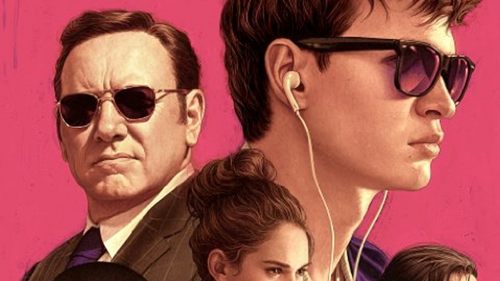Get In: THE DRIVER’s Art Of The Chase
Baby Driver hits theaters this week! Get your tickets here!
“It’s just you and me now, sport.” — Will Graham, Manhunter
Walter Hill’s The Driver is an existential journey into the dream of a city, a mythic film uninterested in realism. The 1978 film’s version of Los Angeles is a labyrinth, a psychic, interior space. This is a city of eternal night, oddly devoid of people, full of liminal spaces: the Bonaventure, Union Station, the Second Street tunnel, bars, hotels, parking garages, abandoned warehouses. It’s an Edward Hopper hallucination, a neon Expressionist purgatory where the Driver, the Detective, and the Player seem fated to play their cat-and-mouse game for eternity.
Writer and director Walter Hill said that The Driver was “the purest script that I ever wrote.” The story is simple: a getaway driver called the Driver (Ryan O’Neal) must elude the detective called the Detective (Bruce Dern) who is determined to catch him. A mysterious woman called the Player (Isabelle Adjani) plays the two men against each other. There are car chases, bank robberies, betrayals and double-crosses, country music. In an interview with Michael Open for Film Directions, Neil Jordan called The Driver “almost a total abstraction.” The film was well-received in Europe, but in America, it was a financial and critical failure. Walter Hill claimed it only got one positive review. Producer Larry Gordon suspected that audiences would’ve accepted the film if it had starred Clint Eastwood or Steve McQueen. But with Love Story’s Ryan O’Neal as its lead, critics treated The Driver like an art film, not an action movie.
The Driver still managed to insinuate itself into collective consciousness and become a template for smart American crime thrillers. It inspired Nicolas Winding Refn’s Drive and Edgar Wright’s Baby Driver. And The Driver provided the basic blueprint for Michael Mann’s films, its DNA in the work of Quentin Tarantino, who called it one of the “coolest movies of all time.” Walter Hill was even approached to direct Heat during its early development in the ‘80s. James Cameron claimed he’d had The Driver in mind when he wrote The Terminator: “Not that I was cribbing; I had only seen the picture once and just had a dim memory of the kinetic forward energy [Walter Hill] had in it.” In Nashville Public Library’s podcast Legends of Film, Walter Hill recalled it was Larry Gordon’s idea to make a film about a getaway driver. Gordon first pitched the idea to Hill, then to the studio, and both said yes. Hill wanted to make something pure, believing his directorial debut Hard Times had “genuflected to a lot of traditional Hollywood cliches.” He wanted to make a genre film that “didn’t compromise itself in traditional Hollywood ways.”
In an interview with Patrick McGilligan for Film International, Walter Hill said, paraphrasing his favorite director Howard Hawks: “The real power of movies lies in their connection to our unconscious or semi-conscious dream life, and action movies are about heroism and death. Will he live or will he die is the ultimate drama, isn’t it?” A car chase done well is pure drama. It’s pure action and pure cinema. It’s the crystallization of a story, protagonist and antagonist locked in conflict, tension built and released. Hawks once said, “There is no action when there is no danger.” And the stakes in a car chase couldn’t be higher, with characters’ lives in immediate, tangible danger.
In the film’s press notes, Walter Hill wrote that The Driver was about “the muscle, the sinew, the tissue, the very nerve center of a getaway driver.” And driving is how the Driver expresses himself. He treats cars like a hermit crab switching out shells: a Ford Galaxie 500, a Pontiac Esprit, a cherry red Chevy C10 pickup. The car emotes for the Driver, an extension of him. When the Player enters the Driver’s truck, the film’s sole emotional connection is made — she’s the only character he allows in when he’s off the job. When the Detective’s double-crossing thieves challenge the Driver, asking them how they know he’s that good, he doesn’t fight them. He just tells them to “get in.” And then he wrecks their ostentatious Mercedes-Benz, destroying it piece by piece. The Driver only says 350 words in the film, but in a car, he speaks volumes.
Walter Hill’s script had the leanness of poetry. He’d picked the crime genre’s bones clean and transmuted it into allegory. Author Foster Hirsch told the New York Times: “As much as [noir] movies are hard-bitten and without illusions, there’s also a romanticism about that stance. Doomed romanticism, I guess, is something we think of as Byronic, but it’s obviously a lot older than that, as old as the Greek tragedies, really.” Walter Hill added, “noir is a form that is almost the antithesis of traditional Hollywood filmmaking, in that it accepts the inevitability of fate. There is probably no idea less harmonious with the usual Hollywood storytelling ideal.” In the film that inspired The Driver, Jean-Pierre Melville’s Le Samouraï, Alain Delon’s hitman character falls in love with a woman who represents death, and the police inspector pursuing him represents destiny. It would not be a stretch to suggest that the dynamic between the Driver, the Detective, and the Player is the same. The Detective and the Driver are destined to play their game, and death is the only way to lose.
The Driver blends noir with the lawlessness of a Western, its showdowns involving cars instead of horses. The Driver, the Detective, and the Player are the cowboy, the sheriff, and the gambler. Walter Hill believes all his films are essentially Westerns, and he defined the genre in the making-of documentary for Broken Trail: “What makes a Western a Western to me is that you lack the recourse of civilization to work out whatever the problem is, and therefore characters must work out the dilemmas for themselves.” Detectives represent law and order, but Dern’s Detective is not an agent of civilization — he doesn’t even seem to work in a police station and carries out most of his business on the street or in bars. The Driver’s and the Detective’s conflict exists outside the system, outside of civilization. It’s just between the two of them.
In Heat, De Niro’s Neil McCauley shares the advice he was once given with Pacino’s Vincent Hanna: “Don’t let yourself get attached to anything you are not willing to walk out on in 30 seconds flat if you feel the heat around the corner.” And Hanna claims, “All I am is what I’m going after,” echoing the police inspector in Le Samouraï who tells his assistant, “I never think.” The Driver and the Detective are the pared-down prototypes of McCauley and Hanna. Unlike the men of Heat, The Driver’s characters seem to lack inner lives. Mann’s characters are idiosyncratic, emotional, full of want and desire, longing for faraway places, for a sea luminous with iridescent algae. They dream of normalcy and calm — a life beyond their reach. Hill’s characters are reduced to their most basic drives and obsessions. They are creatures of experience, of being. These characters have no attachments, they are defined by their actions, there is no psychology involved. What makes the Driver the hero of this story is that he lives by a code, and the Detective doesn’t.
Michael Mann’s films and Walter Hill’s The Driver meditate on the symbiotic relationship between detective and criminal, and the existential thrill of the hunt. In dialogue from Hill’s script that he excised from the film, the Player says, “People playing for high stakes have to be able to afford to lose.” The Driver responds, “No they don’t. They just have to be able to enjoy it.” She insists that it’s just a game. The Driver tells her, “They used to have that cartoon. The coyote was always chasing a roadrunner. Never could catch him.” The Player wonders what the point of it is. And the Driver answers, “If they didn’t have the coyote there wouldn’t be any cartoon.” In this cat-and-mouse game between cop and criminal, the Detective doesn’t care about justice. And the Driver doesn’t care about the money. The pleasure of the game isn’t winning, it’s playing.



